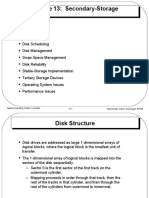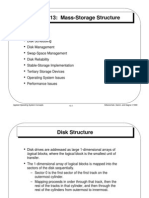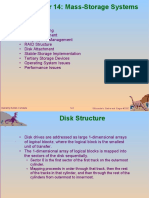Chapter 14: Mass-Storage Systems
Chapter 14: Mass-Storage Systems
Uploaded by
Ujjawal MallikCopyright:
Available Formats
Chapter 14: Mass-Storage Systems
Chapter 14: Mass-Storage Systems
Uploaded by
Ujjawal MallikOriginal Description:
Original Title
Copyright
Available Formats
Share this document
Did you find this document useful?
Is this content inappropriate?
Copyright:
Available Formats
Chapter 14: Mass-Storage Systems
Chapter 14: Mass-Storage Systems
Uploaded by
Ujjawal MallikCopyright:
Available Formats
Chapter 14: Mass-Storage Systems
Disk Structure
Disk Scheduling
Disk Management
Swap-Space Management
RAID Structure
Disk Attachment
Stable-Storage Implementation
Tertiary Storage Devices
Operating System Issues
Performance Issues
Operating System Concepts 14.1 Silberschatz, Galvin and Gagne 2002
Disk Structure
Disk drives are addressed as large 1-dimensional arrays
of logical blocks, where the logical block is the smallest
unit of transfer.
The 1-dimensional array of logical blocks is mapped into
the sectors of the disk sequentially.
Sector 0 is the first sector of the first track on the outermost
cylinder.
Mapping proceeds in order through that track, then the rest
of the tracks in that cylinder, and then through the rest of the
cylinders from outermost to innermost.
Operating System Concepts 14.2 Silberschatz, Galvin and Gagne 2002
Disk Scheduling
The operating system is responsible for using hardware
efficiently for the disk drives, this means having a fast
access time and disk bandwidth.
Access time has two major components
Seek time is the time for the disk are to move the heads to
the cylinder containing the desired sector.
Rotational latency is the additional time waiting for the disk
to rotate the desired sector to the disk head.
Transfer Time, Disk Bandwidth, Throughput, Response
Time
Minimize seek time
Seek time seek distance
Disk bandwidth is the total number of bytes transferred,
divided by the total time between the first request for
service and the completion of the last transfer.
Operating System Concepts 14.3 Silberschatz, Galvin and Gagne 2002
Disk Scheduling (Cont.)
Several algorithms exist to schedule the servicing of disk
I/O requests.
We illustrate them with a request queue (0-199).
98, 183, 37, 122, 14, 124, 65, 67
Head pointer 53
Operating System Concepts 14.4 Silberschatz, Galvin and Gagne 2002
FCFS
Illustration shows total head movement of 640 cylinders.
Operating System Concepts 14.5 Silberschatz, Galvin and Gagne 2002
SSTF
Selects the request with the minimum seek time from the
current head position.
SSTF scheduling is a form of SJF scheduling; may cause
starvation of some requests.
Illustration shows total head movement of 236 cylinders.
Operating System Concepts 14.6 Silberschatz, Galvin and Gagne 2002
SSTF (Cont.)
Operating System Concepts 14.7 Silberschatz, Galvin and Gagne 2002
SCAN
The disk arm starts at one end of the disk, and moves
toward the other end, servicing requests until it gets to the
other end of the disk, where the head movement is
reversed and servicing continues.
Sometimes called the elevator algorithm.
Illustration shows total head movement of 208 cylinders.
Operating System Concepts 14.8 Silberschatz, Galvin and Gagne 2002
SCAN (Cont.)
Operating System Concepts 14.9 Silberschatz, Galvin and Gagne 2002
C-SCAN
Provides a more uniform wait time than SCAN.
The head moves from one end of the disk to the other.
servicing requests as it goes. When it reaches the other
end, however, it immediately returns to the beginning of
the disk, without servicing any requests on the return trip.
Treats the cylinders as a circular list that wraps around
from the last cylinder to the first one.
Operating System Concepts 14.10 Silberschatz, Galvin and Gagne 2002
C-SCAN (Cont.)
Operating System Concepts 14.11 Silberschatz, Galvin and Gagne 2002
C-LOOK
Version of C-SCAN
Arm only goes as far as the last request in each direction,
then reverses direction immediately, without first going all
the way to the end of the disk.
Operating System Concepts 14.12 Silberschatz, Galvin and Gagne 2002
C-LOOK (Cont.)
Operating System Concepts 14.13 Silberschatz, Galvin and Gagne 2002
Selecting a Disk-Scheduling Algorithm
SSTF is common and has a natural appeal
SCAN and C-SCAN perform better for systems that place
a heavy load on the disk.
Performance depends on the number and types of
requests.
Requests for disk service can be influenced by the file-
allocation method.
The disk-scheduling algorithm should be written as a
separate module of the operating system, allowing it to be
replaced with a different algorithm if necessary.
Either SSTF or LOOK is a reasonable choice for the
default algorithm.
Operating System Concepts 14.14 Silberschatz, Galvin and Gagne 2002
Disk Management
Low-level formatting, or physical formatting Dividing a
disk into sectors that the disk controller can read and
write.
To use a disk to hold files, the operating system still
needs to record its own data structures on the disk.
Partition the disk into one or more groups of cylinders.
Logical formatting or making a file system.
Boot block initializes system.
The bootstrap is stored in ROM.
Bootstrap loader program.
Methods such as sector sparing used to handle bad
blocks.
Operating System Concepts 14.15 Silberschatz, Galvin and Gagne 2002
You might also like
- Chapter 14: Mass-Storage SystemsDocument44 pagesChapter 14: Mass-Storage SystemsAjay Krishna NNo ratings yet
- CH 14Document44 pagesCH 14api-3777076No ratings yet
- Mass Storage SystemsDocument43 pagesMass Storage Systemsbikramjeetsingh23No ratings yet
- 5th UnitDocument32 pages5th UnitSathyamurthy DuraikkannuNo ratings yet
- ch10 LatestDocument39 pagesch10 Latestjl289173No ratings yet
- Chapter 10: Mass-Storage Systems: Silberschatz, Galvin and Gagne ©2013 Operating System Concepts - 9 EditionDocument19 pagesChapter 10: Mass-Storage Systems: Silberschatz, Galvin and Gagne ©2013 Operating System Concepts - 9 EditionAr. RajaNo ratings yet
- L12-Mass-Storage SystemsDocument25 pagesL12-Mass-Storage SystemsNeha GargNo ratings yet
- Disk SchedulingDocument19 pagesDisk Schedulingmritunjayk.ug23.ecNo ratings yet
- COS - Week 12Document59 pagesCOS - Week 12barbara.stark915No ratings yet
- CH 12Document49 pagesCH 12rajasekarandpmNo ratings yet
- Mass Storage StructureDocument35 pagesMass Storage Structureapi-25906715100% (1)
- CH 12 Disk SchedulingDocument13 pagesCH 12 Disk SchedulingPRINCE RAJNo ratings yet
- ossDocument18 pagesosssankalpsolanki16No ratings yet
- Disk Scheduling: Silberschatz, Galvin and Gagne ©2013 Operating System Concepts - 9 EditionDocument16 pagesDisk Scheduling: Silberschatz, Galvin and Gagne ©2013 Operating System Concepts - 9 EditionAnshika MishraNo ratings yet
- Chapter 12: Mass-Storage Systems: Silberschatz, Galvin and Gagne ©2009 Operating System Concepts - 8 EditionDocument52 pagesChapter 12: Mass-Storage Systems: Silberschatz, Galvin and Gagne ©2009 Operating System Concepts - 8 EditionNitesh MishraNo ratings yet
- CH 12Document49 pagesCH 12foxhoundzz13No ratings yet
- Chapter 10: Mass-Storage Systems: Silberschatz, Galvin and Gagne ©2013 Operating System Concepts - 9 EditionDocument21 pagesChapter 10: Mass-Storage Systems: Silberschatz, Galvin and Gagne ©2013 Operating System Concepts - 9 EditionVIRAT KOLHINo ratings yet
- ch10 -Ch11 - Ch13 Merged v2 (1) (1)Document56 pagesch10 -Ch11 - Ch13 Merged v2 (1) (1)jubran.bfNo ratings yet
- Chapter 12Document45 pagesChapter 12ManalAmerNo ratings yet
- Mass-Storage Systems - Ch11Document26 pagesMass-Storage Systems - Ch11Ravinder K SinglaNo ratings yet
- Disk Scheduling: Based On The Slides Supporting The Text and B.Ramamurthy's Slides From Spring 2001Document24 pagesDisk Scheduling: Based On The Slides Supporting The Text and B.Ramamurthy's Slides From Spring 2001Lesane17No ratings yet
- Mass_StorageDocument75 pagesMass_StoragejoelbinuphilipNo ratings yet
- OS Chapter 10Document32 pagesOS Chapter 10Omama MaazNo ratings yet
- 14.1 Operating System ConceptsDocument44 pages14.1 Operating System ConceptsRaja NaiduNo ratings yet
- Chapter 12: Mass-Storage SystemsDocument53 pagesChapter 12: Mass-Storage SystemsSuraj ShahNo ratings yet
- CH 11Document49 pagesCH 11aman28No ratings yet
- Mass-Storage SystemsDocument31 pagesMass-Storage SystemssmoldoggoenthusiastNo ratings yet
- Disk Scheduling Algorithms: - Operating System Computer Mansi Mandaviya Mansi Karia 4 (Document15 pagesDisk Scheduling Algorithms: - Operating System Computer Mansi Mandaviya Mansi Karia 4 (Tayga Ina ApdyrahmaanNo ratings yet
- Mass-Storage Systems: Silberschatz, Galvin and Gagne ©2013 Operating System Concepts - 9 EditionDocument44 pagesMass-Storage Systems: Silberschatz, Galvin and Gagne ©2013 Operating System Concepts - 9 EditionmigadNo ratings yet
- Operating systems ch 11Document15 pagesOperating systems ch 11aboudpandpNo ratings yet
- Mass Storage SystemsDocument37 pagesMass Storage SystemsNhungNo ratings yet
- 4/23/01 CIS 3718 Operating Systems 1Document44 pages4/23/01 CIS 3718 Operating Systems 1nagasubbareddyNo ratings yet
- Mass-Storage StructureDocument25 pagesMass-Storage StructureAnsh SinghNo ratings yet
- Mod5MassStorage DisksDocument27 pagesMod5MassStorage DisksJisha C ThankappanNo ratings yet
- Mass-Storage SystemDocument22 pagesMass-Storage Systemmir sumonNo ratings yet
- Secondary Storage StructureDocument21 pagesSecondary Storage StructureManohar DattNo ratings yet
- Disk Structure: Blocks, Where The Logical Block Is The Smallest Unit of Transfer. TheDocument7 pagesDisk Structure: Blocks, Where The Logical Block Is The Smallest Unit of Transfer. TheAmanpreet Shah SinghNo ratings yet
- Slide 08Document76 pagesSlide 08phong haiNo ratings yet
- ch10 MassStorageSystemDocument45 pagesch10 MassStorageSystemHuy NguyễnNo ratings yet
- ch12-mass-storageDocument57 pagesch12-mass-storagemahdimohammadizenganNo ratings yet
- Memory AllocationDocument13 pagesMemory AllocationDhanush M AradhyamathNo ratings yet
- Slides Ch4 Disk SchedulingDocument13 pagesSlides Ch4 Disk SchedulingAbuky Ye AmanNo ratings yet
- Unit 4 Part 1Document66 pagesUnit 4 Part 1Mohammed irfanNo ratings yet
- Chapter 13 PDFDocument9 pagesChapter 13 PDFMd. Ayub KhanNo ratings yet
- Secondarystoragestructure 131126223344 Phpapp02Document28 pagesSecondarystoragestructure 131126223344 Phpapp02psaravanan1985No ratings yet
- Disk SchedulingDocument11 pagesDisk SchedulingShlok GuptaNo ratings yet
- Chapter 12: Mass-Storage SystemsDocument49 pagesChapter 12: Mass-Storage SystemsBilly Joe C. SamonteNo ratings yet
- Ch11 (Mass Storage Structure)Document47 pagesCh11 (Mass Storage Structure)Ali BallahNo ratings yet
- Chapter 12: Mass-Storage Systems: Silberschatz, Galvin and Gagne ©2009 Operating System Concepts - 8 EditionDocument57 pagesChapter 12: Mass-Storage Systems: Silberschatz, Galvin and Gagne ©2009 Operating System Concepts - 8 EditiondeepaNo ratings yet
- ch10C MassStorage DiskSchedulingDocument37 pagesch10C MassStorage DiskSchedulingNhật Thái ĐỗNo ratings yet
- Chapter 10: Mass-Storage Systems: Silberschatz, Galvin and Gagne ©2013 Operating System Concepts - 9 EditionDocument42 pagesChapter 10: Mass-Storage Systems: Silberschatz, Galvin and Gagne ©2013 Operating System Concepts - 9 EditionTania TyagiNo ratings yet
- 12 Mass Storage SystemsDocument43 pages12 Mass Storage SystemsPrajwal KandelNo ratings yet
- Chapter 12: Mass-Storage Systems: Silberschatz, Galvin and Gagne ©2009 Operating System Concepts - 8 EditionDocument23 pagesChapter 12: Mass-Storage Systems: Silberschatz, Galvin and Gagne ©2009 Operating System Concepts - 8 EditionMurgeshNo ratings yet
- Disk Scheduling Mar 30Document24 pagesDisk Scheduling Mar 30cartwoolNo ratings yet
- Os Unit-5Document9 pagesOs Unit-5cse21233No ratings yet
- Os Module 5 Mass StorageDocument14 pagesOs Module 5 Mass Storagevaishnavirai273No ratings yet
- Week #7-Lect #16Document71 pagesWeek #7-Lect #16Fatima MalickNo ratings yet
- Csi 3131 Mod 10 Mass StorageDocument39 pagesCsi 3131 Mod 10 Mass StorageJohnNo ratings yet
- Hard Circle Drives (HDDs): Uncovering the Center of Information StockpilingFrom EverandHard Circle Drives (HDDs): Uncovering the Center of Information StockpilingNo ratings yet
- Background Demand Paging Process Creation Page Replacement Allocation of Frames Thrashing Operating System ExamplesDocument21 pagesBackground Demand Paging Process Creation Page Replacement Allocation of Frames Thrashing Operating System ExamplesUjjawal MallikNo ratings yet
- C2H JFM19Document1 pageC2H JFM19Ujjawal MallikNo ratings yet
- CH 8Document41 pagesCH 8Ujjawal MallikNo ratings yet
- Chapter 7: Process SynchronizationDocument55 pagesChapter 7: Process SynchronizationUjjawal MallikNo ratings yet
- CH 4Document33 pagesCH 4Ujjawal MallikNo ratings yet
- CH 1Document25 pagesCH 1Ujjawal MallikNo ratings yet
- Final For MateDocument7 pagesFinal For MateUjjawal MallikNo ratings yet
- Congestion Control Using NBPDocument22 pagesCongestion Control Using NBPUjjawal MallikNo ratings yet
- Experiment No.: 8: TITLE: Strings HandlingDocument12 pagesExperiment No.: 8: TITLE: Strings HandlingUjjawal MallikNo ratings yet
- Eligibility Criteria - Year 2018 - Engineering (Premier)Document1 pageEligibility Criteria - Year 2018 - Engineering (Premier)Ujjawal MallikNo ratings yet
- Securities and Exchange Board of India: 1. English Language 50 50Document6 pagesSecurities and Exchange Board of India: 1. English Language 50 50Ujjawal MallikNo ratings yet
- 7 4 4 15 23 PDFDocument9 pages7 4 4 15 23 PDFUjjawal MallikNo ratings yet
- CG4Document24 pagesCG4Ujjawal MallikNo ratings yet
- Better Quality Through TestingDocument10 pagesBetter Quality Through TestingUjjawal MallikNo ratings yet
- TCP Design Check CalculationDocument5 pagesTCP Design Check Calculationcrazy devilNo ratings yet
- Data Sheet Cooler Main HXR 400kW %0Document3 pagesData Sheet Cooler Main HXR 400kW %0Resul DemirelliNo ratings yet
- 2223 PCDocument78 pages2223 PCminoltaep4050No ratings yet
- Pressure Booster - V GuardDocument2 pagesPressure Booster - V Guardhalderchayan320No ratings yet
- ABS Encoder Installation and Calibration For M700 SeriesDocument10 pagesABS Encoder Installation and Calibration For M700 SerieslhNo ratings yet
- Chapter Test in Tle 7 Part Iii IvDocument2 pagesChapter Test in Tle 7 Part Iii Ivcindy hembradorNo ratings yet
- TSL 5100G - R.8Document49 pagesTSL 5100G - R.8haryonoari68No ratings yet
- Baxi Luna3 Comfort Full ManualDocument42 pagesBaxi Luna3 Comfort Full ManualStanca CosminNo ratings yet
- Swab Rig Flyer PDFDocument8 pagesSwab Rig Flyer PDFfabricio3fabricio-1No ratings yet
- Model Direct Mount, Cross Pilot: Cavity: T-17ADocument4 pagesModel Direct Mount, Cross Pilot: Cavity: T-17AenovanovaNo ratings yet
- Seamless VS Welded TubesDocument1 pageSeamless VS Welded Tubeshirenkumar patelNo ratings yet
- The Lighting of Industrial Premises ShouldDocument2 pagesThe Lighting of Industrial Premises ShouldSreehari SM TeslaNo ratings yet
- Basic Manual: Av ReceiverDocument20 pagesBasic Manual: Av ReceiverReynaldo Juanito Ludo LafortezaNo ratings yet
- Using MastanDocument64 pagesUsing MastanhellooneoneNo ratings yet
- Garden WindmillDocument2 pagesGarden WindmillSquinkleNo ratings yet
- River Valley News Shopper, September 20, 2010Document39 pagesRiver Valley News Shopper, September 20, 2010Pioneer GroupNo ratings yet
- MEC332 - CHP - 4 - Embodiment DesignDocument26 pagesMEC332 - CHP - 4 - Embodiment DesignFarid AsyrafNo ratings yet
- Croma-Gayatri Westend: Retail InvoiceDocument2 pagesCroma-Gayatri Westend: Retail InvoiceAstroSunilNo ratings yet
- Safe IO DescriptionDocument9 pagesSafe IO Descriptioncesar palomoNo ratings yet
- Gabbioneta RDocument6 pagesGabbioneta Rvrider81100% (1)
- KitchenAid Burr Coffee Grinder KCG8433 - Product ManualDocument40 pagesKitchenAid Burr Coffee Grinder KCG8433 - Product ManualFrankNo ratings yet
- QUOTATION of Tyre Pyrolysis PlantDocument5 pagesQUOTATION of Tyre Pyrolysis PlantRavishankar BansalNo ratings yet
- In The Line of Fire Lifting Operations: What's The Risk?Document3 pagesIn The Line of Fire Lifting Operations: What's The Risk?Muhammad KhalidNo ratings yet
- Project Management BG ENGM91 Version Session 1bDocument5 pagesProject Management BG ENGM91 Version Session 1bADEFIOYE AdeniyiNo ratings yet
- FS-SemperGreenwall CompactLine-ENDocument1 pageFS-SemperGreenwall CompactLine-ENMak HinaultNo ratings yet
- Mj2411 Renewable Energy Technology - 1Document27 pagesMj2411 Renewable Energy Technology - 1Kazim RazaNo ratings yet
- AttendHRM User ManualDocument131 pagesAttendHRM User ManualSeshukumar Mathampalli100% (1)
- CS Datasheet TOPBiHiKu6 TOPCon - CS6W TNDocument2 pagesCS Datasheet TOPBiHiKu6 TOPCon - CS6W TNAlessandro NogueiraNo ratings yet
- LG PDFDocument89 pagesLG PDFAvi RajNo ratings yet
- Cleaning Spiral Wound MembranesDocument4 pagesCleaning Spiral Wound MembranesBhavik ZalaNo ratings yet







































































































